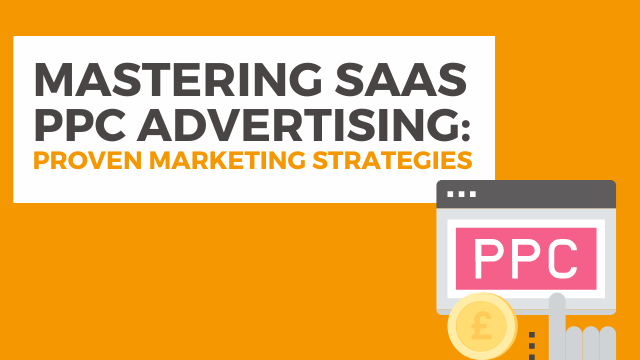PPC works. The stat you’ve probably seen quoted most often is that, as an all-industry average, for every £1 you spend on it, you get £2 back. Yet that return doesn’t just happen. So what strategies can make PPC work for your SaaS business?
Related Articles:
B2B SaaS Inbound Marketing: Strategies That Convert
B2B SaaS Content Marketing Strategies: From Ideas to Conversions
Scaling Success: Marketing Automation Tactics for SaaS Companies
Maximising Reach: 7 Effective SaaS Social Media Strategies
Mastering B2B SaaS Lead Generation: 7 Strategies That Work
Why market your SaaS business using PPC?
Way back when computers were made of stone (well, almost) the big selling point of pay-per-click (PPC) was speed. SEO was all well and good for propelling your business to the top of the search rankings, but it was a long game.
PPC, on the other hand, was the oven-ready instant version. Set your budget, set up the campaign, and your business could be busy collecting clicks by tea time.
Speed is still a big pulling factor for PPC. It’s still the case that an organic SEO campaign takes time to gain momentum and a PPC campaign doesn’t. But I’d argue that benefit has been overtaken by another feature that was, to one degree or another, also always an inherent part of PPC compared with SEO: the ability to target.
Is PPC still important?
Targeting was always important to the PPC user. It’s how you ensured your budget was spent on relevant, valuable, productive clicks rather than wasted on people who stumbled across you with little or no intent to buy.
But marketing has increasingly become about placing the right ad for the right product in front of the right person at the right time. And no type of advertising caters better to that need than PPC, which you can use on Google and other search engines, but also across social media.
With a vast range of ways to customise and personalise ads, PPC is arguably as relevant and important to the marketing mix as it has ever been. There’s a strong argument to say that’s particularly the case for SaaS.
The challenges of PPC for SaaS companies
1. Targeting
Hang on a minute. Didn’t we just say targeting was one of the big benefits of PPC, and now we’re saying it’s a challenge?
Bear with us. Targeting is one of the big benefits of PPC, but for SaaS companies, that presents a bit of a double-edged sword.
On the one hand, it’s not always easy to condense what you offer into a simple, targetable statement. I was speaking with someone last week who gave me the elevator pitch for their SaaS business. It took so long to deliver it that the elevator would have needed to have been in The Shard.
The challenge of explanation can make it harder to identify keywords to target, and that can make it harder to focus your PPC in a way that delivers results.
On the other hand, the challenge of ‘we don’t know what people are going to be typing into Google to find us’ is one you can easily test with PPC. With a small test budget, you can whittle down the potential pool of keyphrases people might be using to find your services, to the ones they’re actually using.
2. Competition
Unless you’ve created something truly unique, the chances are you’re going to face some stiff competition in your marketing. For a fledgeling SaaS business, that adds cost, because the more competitive the keyword you’re targeting, the more expensive each pay-per-click will be.
One way around this is by targeting platforms where ads are cheaper. LinkedIn Ads, for example, may be a more appropriate vehicle for your webinar promotion — and it may work out more cost-effective than Google Ads.
Another option (and I realise you’d expect me to say this, but it’s true) is to put a PPC specialist on the case who can help ensure your budget stretches further and delivers better results.
3. Attention
PPC is a bit like a two-year-old. It constantly wants your attention and then, just when you think you’ve made it happy, it changes it’s mind and wants something else, because that’s what customers do too.
Targeting your PPC isn’t a one-and-done event, so you’ll need to be prepared to invest time as well as money into achieving results. The more attention you give it, the better the outcomes are likely to be. Which is also just like your average two-year-old.
Proven PPC marketing strategies for SaaS Companies
1. Define your objectives
You’re not tied to a single PPC campaign. You can set up as many as you like to target people at different stages of the sales funnel: the browsers, the information seekers, the product comparers and, through retargeting (which we’ll get to in a minute), the people who’ve already checked out your SaaS product and now need another nudge.
But whoever you’re aiming your ad at, it’s important to understand what the objective is, so that:
- You create ads that target the right people in the right way and drive the right outcomes
- You measure the right results
- You understand where each individual campaign fits within the wider digital marketing strategy
It all comes down to search intent: what is it that prospects are seeking to achieve through their search? That intent will differ depending on stage, but it’s vital to be able to establish what the point of your ads are.
2. Say it simply
Whether it’s two lines of a search result or a Facebook/Instagram ad, if you want people to click, you need to ensure that what you present to a prospect is…
- Clear: This isn’t time for nuance. Yes, you may struggle to articulate everything that is part of your SaaS product in just a few words, but lasering in on the ‘so what?’ is essential for grabbing the attention.
- Visually appealing: Could a graphic convey your message better than words? Invest in some bespoke design work that makes your ad stand out in the social feed.
- Evidenced: If you can, add some social proof and/or an award win or two to add credibility.
3. Create a killer landing page
It’s important to remember that the ‘click’ of the pay-per-click is not the end in itself. The click needs to lead a potential customer somewhere worthwhile.
That means not directing them to your website homepage and hoping they’ll do the rest of the legwork in finding the information they were after. It means carrying through the targeting from ad to landing page.
So if the ad posed a question of a specific target group, or if it focused on a particular feature and benefit, the landing page should expand on that, answering questions, solving problems and being generally helpful.
Remember, in putting the landing page together:
- Use clear, bold headlines
- Don’t waffle. Get to the point and if there’s more to discover, link the reader to that content elsewhere in the site (rather than stuffing the landing page with it)
- Go big on imagery or video that supports the targeted prospect
- Include calls to action
- Ideally, have something free to offer, whether it’s a free guide or other downloadable content, or a free trial of the SaaS product
4. Retarget
As we explored earlier, retargeting is about reconnecting with people who’ve already visited your site but haven’t yet committed. There are numerous ways to retarget:
- Via the same channel
- Via your database of contacts (because they’ll already have shown some interest in what you do); or
- Via different channels, so your prospects re-encounter your brand as they hop from Google to Instagram to Facebook, for example
Crucial to retargeting success is the way you segment your audience and define your objectives accordingly. A retargeted prospect could be someone in need of more detailed information about your SaaS product. They could also be on the cusp of buying.
It’s important to understand where prospects are in the sales funnel to make retargeting effective.
5. Never stop optimising…
Back to our two-year-old. PPC needs your attention because your target audience is ever shifting. So once you’ve set up your campaign and its goals, keep monitoring and tweaking to refine it.
6. But don’t overdo it
Ad fatigue is what happens when you see the same ads for the same things again and again. You can minimise this by mixing up your ads, presenting a variety of content in a range of ways.
Ultimately, however, avoiding ad fatigue is about finding the limit of people’s tolerance and not testing their patience. Use A/B testing to post ads at different frequencies and on different days/times to understand what those limits are.
SaaS PPC strategies that work
You know PPC can make a big difference in personalising the way you connect with your target audience. But that doesn’t necessarily mean you have the time or resource to manage your PPC campaigns effectively. So to create better PPC strategies that deliver a better bang for your buck, talk to us.




